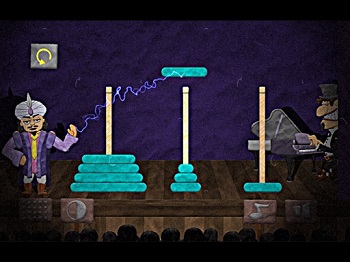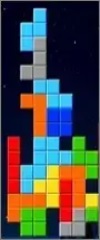- Home
- Better Memory
- Brain Games
- Free Online Brain Games
- Tower of Hanoi Game
Tower of Hanoi Game - Free Online Puzzle

This Tower of Hanoi game puts your brain to the test. This is the classic puzzle Tower Of Hanoi with a retro Logical Theatre theme.
This game is part of the free online brain games collection.
To begin, click the Small, Medium, or Large button under the picture of the game. This opens the game in a new window.
If you like this game, you might enjoy other puzzle games on this site such as Picross Nonograms.
Tower of Hanoi Game - Instructions
Rules in Brief. The goal of this Tower of Hanoi game is to move the stack of disks from the left pole to the right pole.
The moving of disks follows these rules: 1) Only one disk can be moved at a time; 2) To move, drag an upper disk and drop it on another pole or stack; 3) A disk can only be placed on a disk large than itself, i.e., not on a smaller disk.
Tower of Hanoi appears simple until you start playing. Then you may find yourself quickly stumped.
Many people who've tried think it's impossible, especially when playing with 4 or more disks.
SPOILER ALERT: There is a pattern you can follow to easily solve Tower of Hanoi. It works for any number of disks.
I explain it at the bottom of this page. Learn the secret of Tower of Hanoi. Amaze your friends!
To solve the Tower of Hanoi game, you need to move the stacked disks one at a time from the far left pole to the far right pole. What makes this puzzle a challenge is that a larger disk cannot be placed on top of a smaller one.
Tower of Hanoi was a physical puzzle long before it became a flash game. You might want to pick up a set to have around the house or give as a gift. Your local toy store probably has it, and you can find it online.
Although there are various styles of Tower of Hanoi puzzles, they all follow the same basic rules.
This game has an fascinating history. It's also interesting mathematically. This puzzle has appeared on TV shows like Survivor and in movies and books. It has even been used to test the mental function of brain injury patients.
HOW TO PLAY. The Tower of Hanoi game has only two parts:
A set of three poles
A set of 3 or more different-sized disks.
There is a hole in the center of each disk, which allows you to slide the disk on and off the poles. With this flash version of the Tower of Hanoi game, you can play using 3, 4, 5, or 6 disks at a time. The more disks, the more steps required to solve the puzzle.
Select the number of disks you want to play with at the beginning of the game. If you've never tried this puzzle before, leave it at the default 3 disks until you get the hang of it.
As I mentioned, the object of Tower of Hanoi is to move all the disks from the left pole to the right pole. Disks can be moved according to the following rules:
You can only move one disk at a time.
Move disks by sliding the disk off one pole and onto another.
You cannot place a larger disk on top of a smaller disk.
To move a disk, drag the disk with your mouse from one pole to another. I'll refer to the poles as Pole A, Pole B, and Pole C (left to right) from now on.
The starting position for the disks is Pole A (the far left pole). The disks are stacked there in a pyramid shape. The largest disk is on the bottom, with the next largest disk above that, and so on. The smallest disks is on top of the stack.
GAME PLAY EXAMPLE. There are two possible first moves in the Tower of Hanoi game. Both involve moving the smallest disk from the top of the pile on Pole A to either Pole B or Pole C. After moving the smallest disk, you then have the choice to either move the same disk again (a wasted move) or to move the second largest disk from the top of the pyramid to the empty pole. The empty pole is either Pole B or Pole C, depending on where you placed the smallest disk.
OPTIONS AND STATS. The are several options and statistics available in this Tower of Hanoi game. They are located along the bottom of the game window:
Here's what each is used for:
DISCS. Click the Up or Down arrow to the left of the DISCS circle to set the number of disks used in the game.
MOVES (display only). This circle shows how many times you've moved disks so far during the game.
MIN (display only). This shows the minimum number of moves required to solve Tower of Hanoi using the number of disks selected. NOTE: If you follow the spoiler pattern explained at the bottom of this page, you'll be able to solve the puzzle in the fewest number of moves every time.
RESET. If you solve the puzzle and want to play again, click the RESET button to reset the game. This is also useful if you mess up and want to start over or change the number of disks.
SAIT. A link to the game developer's website (in Russia, I think).
The background music of this Tower of Hanoi game is energetic, and I like it. But if you'd rather not hear the music, click the Speaker button in the bottom left corner to mute the sound.
Minimum Number of Moves
Note: The Tower of Hanoi spoiler pattern is explained in the section after this one.
There is a minimum number of moves that must be made to solve the Tower of Hanoi game. This can be calculated mathematically based on the number of disks. Of course, you can solve the puzzle in more than the minimum number of moves, if your choice of moves is not perfectly efficient.
The following formula can be used to calculate the fewest number of moves needed to solve Tower of Hanoi. (I have a math degree, so I like this kind of stuff. ![]() )
)
For example, the minimum number of moves to solve the 3-disk Tower of Hanoi is: 23-1. This works out as 2 x 2 x 2 - 1, or 8-1 = 7.
The minimum number of moves needed to solve the 4-disk Tower of Hanoi is: 24-1. This works out as 2 x 2 x 2 x 2 - 1, or 16-1 = 15.
Therefore, the minimum number of moves to solve every level of this game is as follows:
3 disks - 7 moves
4 disks - 15 moves
5 disks - 31 moves
6 disks - 63 moves
The numbers quickly get big. A Tower of Hanoi game with 10 disks played perfectly would take 1,023 moves to complete!
Tower of Hanoi Spoiler
IMPORTANT: Tower of Hanoi is far more challenging if you don't know the spoiler pattern. If you'd rather solve the game using only your brain power, escape now by clicking this arrow to return to the top of the page: ![]()
Ready for the big secret? This is how the Tower of Hanoi pattern works:
Alternate moving the smallest piece with the other pieces. In other words, you should move the smallest piece every other move.
If the number of starting disks is even, move the smallest piece one pole to the right each time. Once at Pole C (the pole on the far right), move the smallest disk two poles to the left, back to the starting pole (Pole A). Repeat this process until the game is solved.
If the number of starting disks is odd, move the smallest piece all the way to the far right pole (Pole C) on the first turn. Then move it one pole to the left each time, jumping to Pole C after Pole A. Repeating this process until the game is solved.
This solution works perfectly for any number of disks. Give it a try with 4 or 5 disks, and you'll be impressed how fast you can solve the Tower of Hanoi puzzle.
As you can see, there's not much to this trick. Practice several times using the Tower of Hanoi flash game above, and you should be able to remember this spoiler easily.
You never know when it might come in handy. During an episode of the TV show Survivor that aired in September 2011, the two teams were challenged to see who could solve the Tower of Hanoi game fastest.
Both Survivor contestants struggled a bit to figure it out. Had just one of the two players known this easy spoiler pattern in advance, he would have looked like a genius by solving the puzzle in no time flat.
Regularly working on puzzles like this Tower of Hanoi game can improve your concentration and reasoning skills. Even if you know the spoiler, you still have to concentrate and pay attention. For best results, play brain games like this one for at least 10-15 minutes each day!
Published: 03/28/2012
Last Updated: 12/23/2022

Newest / Popular
Multiplayer
Board Games
Card & Tile
Concentration
Math / Memory
Puzzles A-M
Puzzles N-Z
Time Mgmt
Word Games
- Retro Flash -
Also:
Bubble Pop
• Solitaire
• Tetris
Checkers
• Mahjong Tiles
•Typing
No sign-up or log-in needed. Just go to a game page and start playing! ![]()
Free Printable Puzzles:
Sudoku • Crosswords • Word Search







